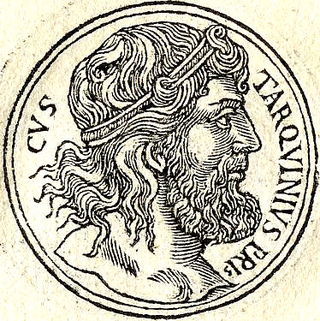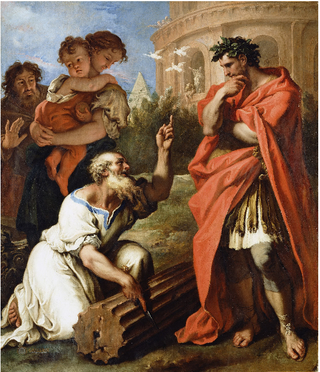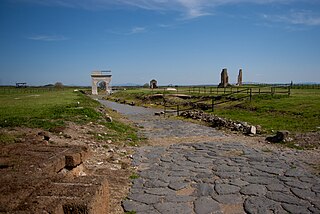
Aulus Vibenna (Etruscan : Avile Vipina) was an Etruscan nobleman from Vulci of the 6th century BC and the brother of Caelius Vibenna (Caile Vipina in Etruscan).

Aulus Vibenna (Etruscan : Avile Vipina) was an Etruscan nobleman from Vulci of the 6th century BC and the brother of Caelius Vibenna (Caile Vipina in Etruscan).

The historical existence of Aulus Vibenna, citizen of Vulci, [2] is confirmed by archaeological finds, including a cup found at the sanctuary of Portonaccio near Veii, a bucchero chalice (of which only the high cylindrical foot remains from the sanctuary of Portonaccio) from the period in which tradition places it (second quarter or middle of the 6th century BC) and which bears the dedicating inscription mini muluva[an]ece avile vipiienas, i.e. "Aulus Vibenna dedicated me". [3] [4] Aulus, with this gift, had wanted to honour the sanctuary of Veii, whose prestige was such that it attracted as worshipers not only prominent local personalities but also aristocrats from other large Etruscan cities. [5]
Another later vase, a red-figured Etruscan cup preserved in the Rodin Museum in Paris, probably discovered in Vulci and dating from the fifth century BC, bears the Etruscan inscription Avles V(i)pinas naplan, i.e. "cup of Aulus Vibenna", [6] which confirms the charisma of this figure, whose memory resurfaces a century later. [7] [8]
Aulus could have been present in Rome. Arnobius, referring to Fabius Pictor, alludes to the murder of Aulus (whose head would be the one found on the Capitol during excavations for the foundation of the temple of Jupiter), by a "slave of his brother" (Servius Tullius). [9] The Capitol, a pseudo-etymology for which is caput Oli, is said to have taken its name Oli from Auli. [10]
The Vibenna brothers also appear on an Etruscan mirror from Bolsena and on four cinerary urns from Chiusi. [8]
Aulus and his brother Caelius Vibenna are well represented in the Etruscan tradition.
The François tomb at Vulci contained a fresco showing Aulus and Caelius Vibenna taking part in one of these adventures. The fresco is from the Hellenistic period and incorporates more ancient motifs from the Etruscan tradition. [11]
It represents a battle scene showing Caelius, Aulus Vibenna and Mastarna (the Etruscan name of Servius Tullius) [2] with companions named 'Larth Ulthes', 'Rasce' and 'Marce Camitlnas'. These images show the execution of enemies whose names are 'Laris Papathnas Velznach' (from Volsinii), 'PESNA Arcmsnas Sveamach' (from Sovana), 'Venthical' [...] 'plsachs' and 'Cneve Tarchunies Rumach' (equated to 'Cnaeus Tarquinius of Rome', possibly Lucius Tarquinius Priscus).
The group is portrayed as having taken prisoner Caelius, Aulus, Rasce and Marce, but while they were sleeping, Larth Ulthes broke into their camp, armed with swords which he gave to his companions. While the prisoners kills their captors, Mastarna frees Caelius Vibenna. [12] The fresco, together with the finding of the bucchero, which is coeval with the reign of Servius Tullius, suggests that the Vibenna brothers are historical figures, Etruscan military leaders who took part in the struggles for dominance over Rome, having the Tarquins as their adversaries [11] and helping Servius Tullius oust from power Lucius Tarquinius Priscus. [13] It is not unlikely that Aulus, while being in the surroundings of Rome, decided to make an offer to the sanctuary of Veii, located very close to the city which he wanted to conquer. [11]

Lucius Tarquinius Priscus, or Tarquin the Elder, was the legendary fifth king of Rome and first of its Etruscan dynasty. He reigned for thirty-eight years. Tarquinius expanded Roman power through military conquest and grand architectural constructions. His wife was the prophetess Tanaquil.

Lucius Tarquinius Superbus was the legendary seventh and final king of Rome, reigning 25 years until the popular uprising that led to the establishment of the Roman Republic. He is commonly known as Tarquin the Proud, from his cognomen Superbus.

Servius Tullius was the legendary sixth king of Rome, and the second of its Etruscan dynasty. He reigned from 578 to 535 BC. Roman and Greek sources describe his servile origins and later marriage to a daughter of Lucius Tarquinius Priscus, Rome's first Etruscan king, who was assassinated in 579 BC. The constitutional basis for his accession is unclear; he is variously described as the first Roman king to accede without election by the Senate, having gained the throne by popular and royal support; and as the first to be elected by the Senate alone, with support of the reigning queen but without recourse to a popular vote.
This article concerns the period 579 BC – 570 BC.

Veii was an important ancient Etruscan city situated on the southern limits of Etruria and 16 km (9.9 mi) north-northwest of Rome, Italy. It now lies in Isola Farnese, in the comune of Rome. Many other sites associated with and in the city-state of Veii are in Formello, immediately to the north. Formello is named after the drainage channels that were first created by the Veians.

Etruscan religion comprises a set of stories, beliefs, and religious practices of the Etruscan civilization, heavily influenced by the mythology of ancient Greece, and sharing similarities with concurrent Roman mythology and religion. As the Etruscan civilization was gradually assimilated into the Roman Republic from the 4th century BC, the Etruscan religion and mythology were partially incorporated into ancient Roman culture, following the Roman tendency to absorb some of the local gods and customs of conquered lands. The first attestations of an Etruscan religion can be traced back to the Villanovan culture.
The gens Tullia was a family at ancient Rome, with both patrician and plebeian branches. The first of this gens to obtain the consulship was Manius Tullius Longus in 500 BC, but the most illustrious of the family was Marcus Tullius Cicero, the statesman, orator, and scholar of the first century BC. The earliest of the Tullii who appear in history were patrician, but all of the Tullii mentioned in later times were plebeian, and some of them were descended from freedmen. The English form Tully, often found in older works, especially in reference to Cicero, is now considered antiquated.

Tanaquil was the queen of Rome by marriage to Tarquinius Priscus, the fifth King of Rome.

The gens Tarquinia was a plebeian family at ancient Rome, usually associated with Lucius Tarquinius Priscus and Lucius Tarquinius Superbus, the fifth and seventh Kings of Rome. Most of the Tarquinii who appear in history are connected in some way with this dynasty, but a few appear during the later Republic, and others from inscriptions, some dating as late as the fourth century AD.
Demaratus, frequently called Demaratus of Corinth, was the father of Lucius Tarquinius Priscus, the fifth King of Rome, the grandfather or great-grandfather of Lucius Tarquinius Superbus, the seventh and last Roman king, and an ancestor of Lucius Junius Brutus and Lucius Tarquinius Collatinus, the first consuls of the Roman Republic.

Vulci or Volci was a rich Etruscan city in what is now northern Lazio, central Italy.

The sanctuary of Minerva at Portonaccio is an archaeological site on the western side of the plateau on which the ancient Etruscan city of Veii, north of Rome, Italy, was located. The site takes its name from the locality within the village of Isola Farnese, part of Municipio XX, city of Rome.
Giovanni Colonna is a contemporary Italian scholar of ancient Italy and, in particular, the Etruscan civilization.

Etruscan art was produced by the Etruscan civilization in central Italy between the 10th and 1st centuries BC. From around 750 BC it was heavily influenced by Greek art, which was imported by the Etruscans, but always retained distinct characteristics. Particularly strong in this tradition were figurative sculpture in terracotta, wall-painting and metalworking especially in bronze. Jewellery and engraved gems of high quality were produced.

The Tomb of Orcus, sometimes called the Tomb of Murina, is a 4th-century BC Etruscan hypogeum in Tarquinia, Italy. Discovered in 1868, it displays Hellenistic influences in its remarkable murals, which include the portrait of Velia Velcha, an Etruscan noblewoman, and the only known pictorial representation of the daemon Tuchulcha. In general, the murals are noted for their depiction of death, evil, and unhappiness.
Caelius Vibenna was a noble Etruscan who lived c. 750 BCE and brother of Aulus Vibenna.

The François Tomb is an important painted Etruscan tomb from the Ponte Rotto Necropolis in the Etruscan city of Vulci, Lazio, in central Italy. It was discovered in 1857 by Alessandro François and Adolphe Noël des Vergers. It dates to the last quarter of the fourth century BC. The tomb seems to belong to the Etruscan family of the Saties and one of its chief occupants is Vel Saties, who appears with his dwarf, Arnza.
The gens Caelia was a plebeian family at ancient Rome. The nomen Caelius is frequently confounded with Coelius and Caecilius, with some individuals referred to as Caelius in manuscripts, while appearing as Coelius or Coilius on coins. Although the Caelii asserted their great antiquity, none of them attained any of the higher offices of the Roman state until the praetorship of Publius Caelius in 74 BC, and the first of this gens who obtained the consulship was Gaius Caelius Rufus in AD 17. The emperor Balbinus was a descendant of the Caelii.
Arruns Tarquinius was the brother of Lucius Tarquinius Superbus, the seventh and last King of Rome.
Tyrrhenika is a 20-book lost work written in ancient Greek by the Roman emperor Claudius. It was a historical work on the Etruscans and their civilization.